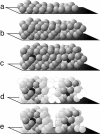The selective advantage of microbial fratricide
- PMID: 15939890
- PMCID: PMC1150870
- DOI: 10.1073/pnas.0503828102
The selective advantage of microbial fratricide
Figures

Comment on
-
Competence-programmed predation of noncompetent cells in the human pathogen Streptococcus pneumoniae: genetic requirements.Proc Natl Acad Sci U S A. 2005 Jun 14;102(24):8710-5. doi: 10.1073/pnas.0500879102. Epub 2005 May 31. Proc Natl Acad Sci U S A. 2005. PMID: 15928084 Free PMC article.
References
-
- Knobler, S. L., Lemon, S. M., Najafi, M. & Burroughs, T., eds. (2003) The Resistance Phenomenon in Microbes and Infectious Disease Vectors (Natl. Acad. Press, Washington, DC), pp. 3-12. - PubMed
Publication types
MeSH terms
Substances
LinkOut - more resources
Full Text Sources
Medical

